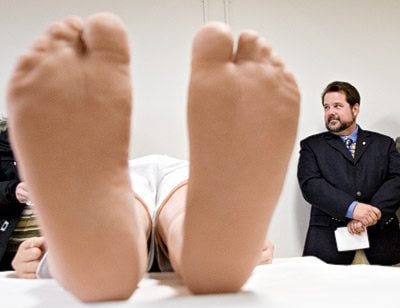Reporters, photographers, students and officials all crammed into a small room in a Yukon College residency basement with the promise of seeing a breakthrough in medical training technology.
There, lying prostrate on a small hospital bed, was the object of their curiosity: a full-sized mannequin, mouth agape, eyes blinking regularly, his chest heaving in and out with each “breath.”
Seated at a computer console, special projects director Stu Mackay guided the crowd through the dummy’s many abilities.
“When his oxygen levels go down … his toes will turn blue,” said Mackay.
A series of blue LEDs lit up under iStan’s fingernails.
A regular pulse courses through iStan’s entire body, explained Mackay.
A nursing student quickly took hold of iStan’s wrist.
“Apparently I shouldn’t be a paramedic anymore,” he said after failing to identify the pulse.
Does the dummy suffer convulsions?
At the click of a mouse, hidden gyroscopes began to spin within iStan, oscillating his entire body.
Tears started streaming down iStan’s cheeks as a pitiful crying sound emanated from his lips.
“My leg hurts,” he said in an accent from the US Midwest.
Uneasy laughter chortled through the room.
“If you make a mistake, you’re going to see the mistake and hopefully, you’ll learn from that — on a simulator,” said Mackay.
Cameras and microphones surround iStan’s perpetual examination room — recording every detail of his life onto a massive server. The server is accessible through the internet, providing students with unique opportunities to revisit audio, video and vital sign data of their classroom time spent caring for iStan.
Specific scenarios can be examined to determine exactly what went wrong – or right — in the course of a medical scenario.
“It’s a wonderful teaching tool. Not just for what you do here, but what you do after class,” said Mackay.
The real power of iStan is giving students the ability to identify complex medical scenarios.
A nursing student may be able to separately recognize a nosebleed, a convulsion, hypothermia and a heart attack. But what about a combination of all four?
“As the student works through the scenario, depending on whether they recognize the condition correctly or incorrectly, the patient will respond realistically,” said Mackay.
The dummy is well-prepped for a long lifetime of constant medical tragedy.
Heart attacks and strokes are frequent.
He can be stabbed — with a realistic bowel protruding from the stab wound.
Or, he can have his arm sheared off in a grisly road accident. Students would administer the wound amidst cascades of spurting fake blood.
“Do his eyes really dilate?” one nursing student asked Mackay. Indeed they do.
It’s not all bad for the unlucky dummy, his stomach can even be stretched to accommodate a pregnancy.
Medical emergencies can often be a wet, sticky and gooey business – but iStan is up for the task. He sweats, urinates, vomits and bleeds from a rich variety of orifices.
A complex network of tubes and piping equip iStan with his many bodily fluids. An online 32-page recipe book provides teachers with instructions for creating vomit, infected urine, blood clots and pus.
Fully wireless and portable, iStan can even be placed in urban or household situations for paramedic training. Students could practise emergency on-site first aid on a critically injured iStan found crumpled at the bottom of an elevator shaft.
But at a price tag of close to $120,000, iStan is staying safely in his hospital bed for the next little while, said Mackay.
In addition to being an excellent pincushion for needles, catheters, IVs and tubes, iStan is able to react realistically to hundreds of simulated drugs — from morphine to dopamine.
iStan can even be primed with a lethal cocktail of illegal drugs and alcohol, forcing a nursing student to address a possible overdose while dealing with an uncommunicative patient,
“If a patient is not talking, you have to come at the situation with very little information,” said Tara Goodwin, a first year nursing student.
“(iStan) definitely takes the pressure off,” she added.
Realistic simulation has always been a goal of medical training. Better to practise sticking a needle into an orange before sticking one into a preschooler.
But iStan represents a whole new, and previously unheard of realm of accurate simulation.
“We could simulate things before through videos or other types of audio visual aids — tapes that show heart sounds and so on,” said Mackay.
“(On iStan), students can actually hear the heart sounds on a body, they know where to put the stethoscope — how to hear the sounds,” he added.
“Some poor guy had to put a catheter in him and he was crying like crazy,” said Mackay to a colleague.
